Have you ever wondered what makes cats such incredible hunters, stealthy movers, and agile climbers? A significant part of their prowess lies in the fascinating structure of their skulls. The anatomy of a cat skull is a marvel of evolution, perfectly designed for their predatory lifestyle. From their sharp teeth to their wide eye sockets that allow for excellent night vision, every feature serves a purpose.
This blog post explores 10 amazing facts about cat skull anatomy, showcasing how unique and specialized these creatures are. Whether you’re a cat owner, a biology enthusiast, or just curious, you’ll find these insights fascinating. Understanding feline skull anatomy offers a deeper appreciation for their remarkable adaptations and abilities.
Join us on this journey into the intricacies of cat skulls. You’ll discover how their anatomy reflects their predatory instincts, agility, and evolution. By the end, you’ll see your feline friends in a whole new light. Let’s dive in!
The Unique Structure of a Cat Skull
Cat Skull Size and Shape
Cats possess a compact and rounded skull, distinct from many other mammals. This shape optimizes agility and hunting efficiency, enabling quick, precise movement with minimal energy expenditure. The rounded design also offers better protection for their brain, which is relatively large compared to their body sizes.
Domestic cats have skulls that are slightly smaller and less robust than their wild counterparts, such as tigers or lions. This difference results from domestication and reduced reliance on physical hunting. However, the essential characteristics, like the zygomatic arch that supports strong jaw muscles, remain consistent across all felines.
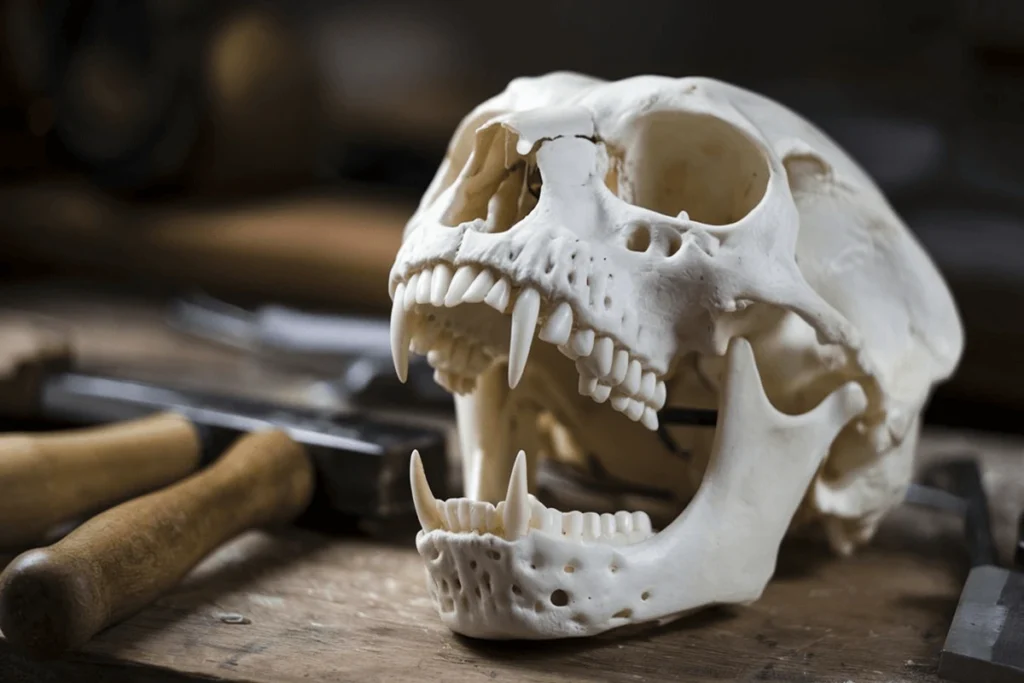
Interestingly, the size of a cat’s skull is proportional to its ability to navigate tight spaces. Cats can fit through surprisingly small gaps because their skull, and consequently their body, is narrow and flexible. This feature is a survival trait that allows them to escape predators or pursue prey into burrows and other confined areas.
Orbital Sockets: Perfect for Night Vision
One of the most striking features of a cat skull is its large orbital sockets, which house their eyes. These sockets are significantly larger than those of many other mammals, giving cats their characteristic wide-eyed appearance. This adaptation isn’t just aesthetic—it’s a critical feature that enhances their ability to see in low light, making them exceptional nocturnal hunters.
The large size of the sockets allows for bigger eyes, which capture more light, even in dim conditions. Combined with a highly reflective layer behind the retina called the tapetum lucidum, cats can maximize available light to improve their vision in the dark. This is why their eyes often seem to glow in the dark when light reflects off them.
Additionally, the positioning of their eyes gives cats excellent depth perception and a wider field of vision, essential for calculating distances during a pounce or jump. This trait evolved to suit their predatory lifestyle, enabling them to strike prey with precision, even under cover of darkness.
Nasal Passages for Superior Sense of Smell
A cat’s skull also features intricate nasal passages that contribute to their highly developed sense of smell. While their sense of smell isn’t as strong as that of dogs, it’s far superior to that of humans, making it an important tool for detecting prey, recognizing familiar scents, and even identifying danger.
Inside the nasal cavity, cats have a complex system of turbinates—thin, curled bones covered with sensitive tissue that helps detect a wide range of odors. This structure increases the surface area for olfactory receptors, enhancing their ability to process scents.
Interestingly, cats also have a Jacobson’s organ (also known as the vomeronasal organ) located on the roof of their mouth. This organ allows them to analyze pheromones and other chemical signals in the air, which is why you might see a cat curl its lip or open its mouth slightly in what’s called the Flehmen response. This behavior helps them draw scents into the Jacobson’s organ for closer examination.
These advanced nasal structures are vital not only for hunting but also for communication, as cats use scent marking and pheromones to establish territories and bond with other cats.
The Jaw and Teeth: Tools for Hunting
Sharp Teeth for Precision
Cats are obligate carnivores, meaning their diet relies entirely on meat, and their teeth are perfectly designed for precision hunting and processing their prey. A cat’s teeth are specialized for grabbing, tearing, and shearing rather than grinding or chewing.
- Canines for Gripping and Killing: The long, sharp canine teeth are one of the most distinctive features of a cat’s skull. These teeth act like daggers, allowing cats to pierce through the flesh of their prey and deliver a precise, fatal bite to the neck or spine.
- Incisors for Grooming and Nibbling: The small, sharp incisors located at the front of the jaw are not only used for biting food but also for grooming. Cats use these teeth to nibble and remove dirt or debris from their fur.
- Carnassial Teeth for Shearing Meat: Cats possess specialized molars, called carnassials, located at the back of the jaw. These teeth function like scissors, helping them tear chunks of meat into smaller, more manageable pieces. Unlike herbivores, cats lack flat molars for grinding, as their diet doesn’t require it.
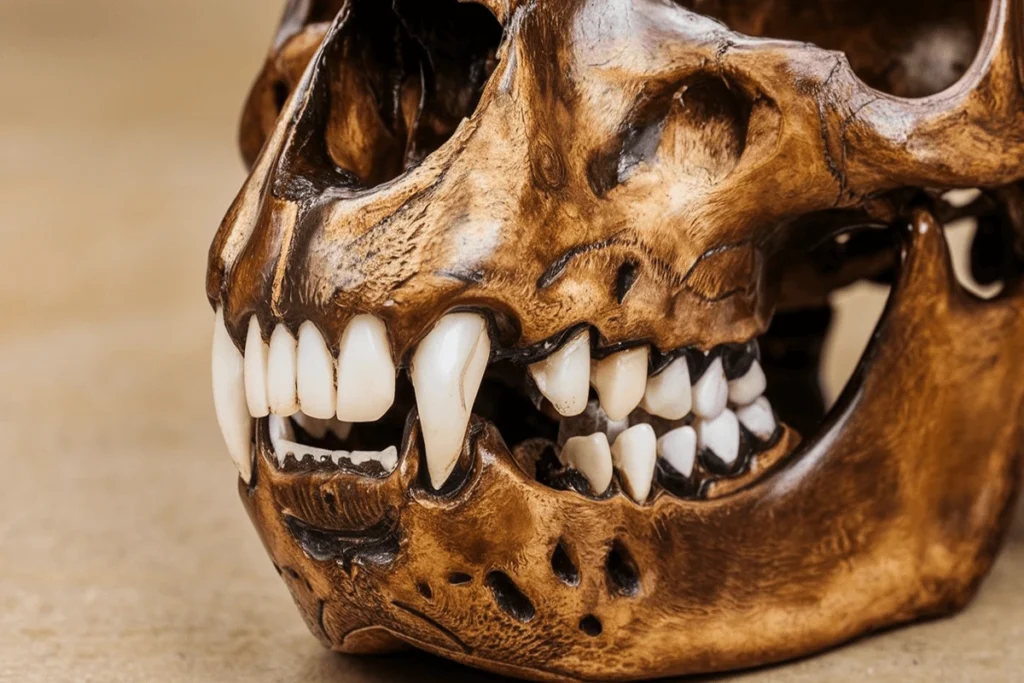
The teeth’s arrangement reflects their evolutionary role as hunters, allowing cats to efficiently kill prey and eat without wasting energy. Their sharp teeth also require care—dental issues like tartar buildup can impact their ability to eat, which is why maintaining oral health is essential for pet cats.
Powerful Jaw Structure
The jaw structure of a cat is another critical adaptation for their carnivorous lifestyle. A cat’s skull is designed to support strong jaw muscles, allowing them to deliver powerful and precise bites.
- Zygomatic Arch and Muscle Attachment: The zygomatic arch, a bony bridge in the skull, provides a solid attachment point for the masseter and temporalis muscles, which control the jaw’s movement. These muscles are essential for delivering the force needed to pierce through tough hides or bones of prey.
- Limited Jaw Mobility: Unlike herbivores, which require side-to-side jaw movement for grinding plant material, a cat’s jaw has limited lateral movement. This allows them to focus all their strength on a powerful up-and-down motion, ideal for crushing and tearing flesh.
- Efficient Bite Mechanics: The jaw is structured to ensure that the teeth come together precisely, maximizing the effectiveness of their bite. This precision ensures they can catch, kill, and consume prey quickly, minimizing struggle and energy expenditure.
In wild cats, jaw strength is critical for survival, while domestic cats retain this ability for play and self-defense. Watching a cat pounce on a toy or chew on a treat offers a glimpse into how this powerful structure works.
Adaptations for Carnivorous Diets
The anatomy of a cat’s skull and teeth reflects their evolutionary role as obligate carnivores. Unlike omnivores or herbivores, cats have evolved with specific adaptations that support a diet consisting exclusively of animal protein.
- Reduced Molars for Tearing, Not Chewing: Cats have a reduced number of molars compared to herbivorous or omnivorous mammals. Their molars are sharp-edged and designed to slice through meat rather than grind plant material. This is why cats don’t chew their food extensively—they rely on their stomach and intestines to break it down.
- Short Digestive Tract Complemented by Skull Design: The cat skull’s role is directly tied to their dietary needs. Since their short digestive tract processes animal proteins quickly, cats need to consume meat in manageable chunks, which their teeth and jaws are designed to handle efficiently.
- Focus on Protein Consumption: Cats’ teeth and jaw structure prioritize processing protein-rich diets over carbohydrate-rich foods. This dietary adaptation explains why cats thrive on high-protein meals and struggle to digest grains or plant matter effectively.
Even in domestic cats, these adaptations remain prominent. This is why you’ll often observe your cat gnawing on meat with precision or instinctively playing with toys that mimic the size and texture of prey.
Evolution of The Cat Skull Over Time
From Wild Cats to Domestic Companions
The evolution of domestic cats (Felis catus) traces back to their wild ancestors, such as the African wildcat (Felis silvestris lybica). Over time, subtle changes occurred in their skull anatomy as they adapted to living alongside humans.
- Domestication and Skull Size: Domestic cats generally have smaller, less robust skulls than their wild relatives. This change is due to domestication, as they no longer need to hunt large prey or face survival challenges. However, they retain features for hunting smaller prey, like rodents.
- Behavioral Changes Reflected in Anatomy: Domestication favored traits that made cats more sociable and suited for human companionship. This shift reduced stressors, leading to changes in their skull structure compared to wild cats.
- Similarities to Wild Cats: Despite these differences, domestic cats’ skulls remain similar to those of wild cats. Their behavior, such as stalking, pouncing, and chewing toys, still reflects their ancestral hunting instincts.
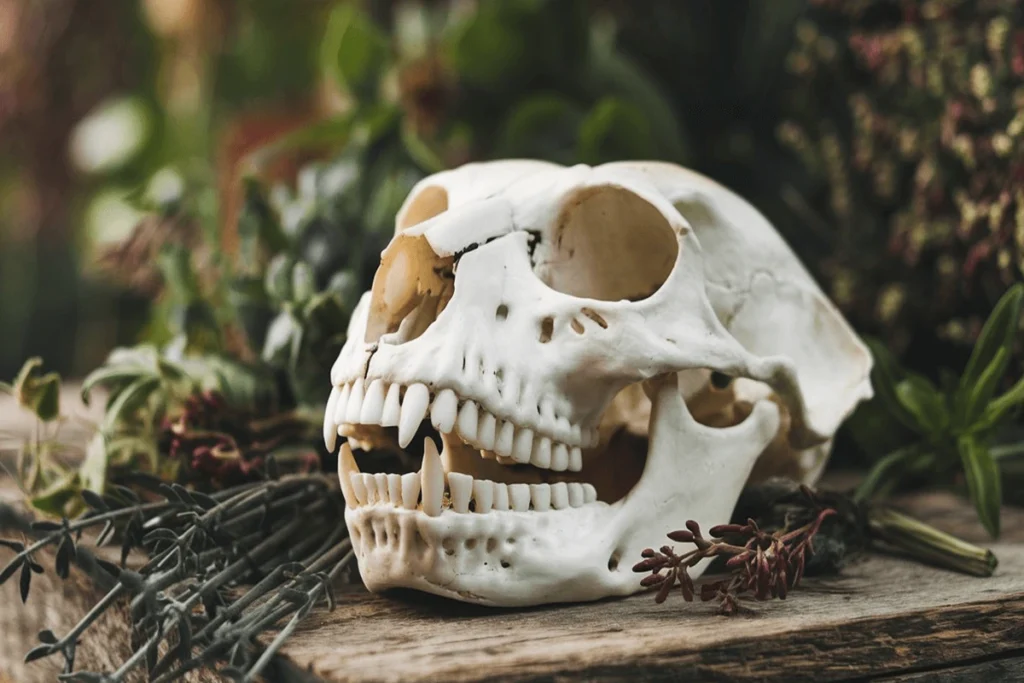
Adaptations for Hunting Efficiency
The anatomy of a cat’s skull has been honed by evolution to maximize their hunting efficiency. These adaptations allow cats to excel as stealthy predators, whether in the wild or in your backyard.
- Zygomatic Arch for Jaw Strength: The prominent zygomatic arch in a cat’s skull supports strong jaw muscles, allowing for precise and powerful bites. This feature ensures they can quickly subdue their prey with minimal effort.
- Forward-Facing Eyes for Depth Perception: Cats have forward-facing eyes that provide excellent binocular vision, essential for judging distances accurately. This ability is critical when they leap or pounce on prey.
- Streamlined Skull for Stealth: The rounded and compact shape of a cat’s skull minimizes resistance when they move through tall grass or other obstacles. Combined with their flexible spine, this helps cats move silently and approach prey without detection.
- Sharp Teeth for Shearing Meat: Cats have a dental structure that supports their carnivorous diet, with sharp canines and carnassial teeth designed to tear flesh efficiently. This adaptation allows them to consume their prey quickly, reducing the risk of losing their meal to other predators.
These traits showcase how every aspect of a cat’s skull anatomy is finely tuned for hunting success, even in domestic breeds that no longer rely on hunting for survival.
Why Cat Skull Are Smaller Than Dog Skull
One of the most noticeable differences between cats and dogs is the size of their skulls, which reflects their evolutionary roles, diets, and behaviors.
- Body Size Proportions: Cats generally have smaller skulls than dogs because of their smaller body size. Cats evolved to hunt small prey like birds and rodents, which requires agility and speed rather than brute strength. Their compact skulls contribute to their lightweight and flexible frame, allowing them to move swiftly and quietly.
- Dietary and Hunting Needs: Cats are solitary hunters, unlike many dog species that evolved as pack animals. As a result, they didn’t need large, robust skulls to support prolonged chases or attacks on large prey. Instead, their skulls evolved to prioritize stealth, precision, and speed, focusing on traits like sharp teeth and large eye sockets rather than overall size.
- Brain-to-Skull Ratio: While cats have smaller skulls, their brain-to-body ratio is relatively high, indicating intelligence suited for problem-solving and hunting. Dogs, on the other hand, have larger skulls partly due to the need for stronger jaws and teeth to hunt and scavenge in groups.
- Facial Structure Differences: Dogs often have elongated snouts, which add to the overall size of their skulls. Cats, with their shorter, rounded faces, are designed for quick bites and efficient consumption of prey, further explaining the difference in skull size.
In summary, the smaller size of cat skulls reflects their evolutionary specialization as agile, solitary hunters, while the larger skulls of dogs are adaptations to their roles as pack animals and versatile predators.
Differences Between Cat Skull and Other Mammals
Comparison with Dog Skulls
The differences between cat and dog skulls reflect their distinct evolutionary paths, dietary needs, and hunting behaviors.
- Facial Structure and Snout Length: Cats have shorter, more rounded faces compared to dogs, whose elongated snouts are designed for a wider range of tasks, including sniffing out scents over long distances. Cats, as stealthy predators, rely more on acute vision and less on an extended nasal cavity. Their compact facial structure allows for greater precision and efficiency in biting and consuming prey.
- Jaw Mechanics: Dogs have a more robust jaw structure, built for crushing and grinding bones and tougher food items. In contrast, cats possess jaws specialized for delivering precise, killing bites and tearing flesh. Their jaws move in a powerful up-and-down motion, while dogs benefit from a slightly wider range of lateral jaw motion for chewing.
- Eye Socket Placement: Cats’ forward-facing eye sockets provide excellent binocular vision, which is crucial for judging distances while hunting. Dogs, while also forward-facing, often have wider-set eyes, offering a broader field of vision but less depth perception compared to cats.
- Dental Differences: Cats have fewer teeth than dogs, with 30 teeth compared to a dog’s 42. A cat’s teeth are highly specialized for slicing and tearing meat, whereas a dog’s teeth are more generalized, with molars adapted for grinding in addition to tearing. These differences reflect their diets: cats focus on meat exclusively, while dogs evolved as omnivores capable of eating a variety of foods.
Feline Brain Case
The brain case of a cat skull holds fascinating insights into their intelligence and sensory processing capabilities.
- Compact but Efficient Design: Cats have a relatively large brain compared to their body size, housed in a compact brain case. This efficient design minimizes weight while still supporting a high level of sensory processing and coordination needed for hunting and survival.
- Focus on Vision and Coordination: The shape of the brain case reflects the cat’s reliance on vision and motor skills. The areas of the brain responsible for sight and body coordination occupy significant space, explaining their incredible reflexes and spatial awareness.
- Evolutionary Insights: The size and shape of a cat’s brain case reveal their solitary hunting lifestyle. Unlike dogs, which evolved to work in packs and developed complex social behaviors, cats rely more on independent problem-solving and instinctual behaviors. This is reflected in their brain’s focus on sensory input and quick decision-making, rather than complex social processing.
Unique Temporal and Zygomatic Structures
The temporal and zygomatic structures in a cat’s skull highlight their specialization as efficient predators.
- Temporal Bone and Jaw Strength: The temporal bone in a cat’s skull anchors the temporalis muscle, a key component in their strong and precise bite. This muscle generates significant force when cats clamp down on their prey, ensuring a quick and effective kill. The placement and size of the temporal bone enhance the muscle’s efficiency, contributing to their exceptional hunting ability.
- Zygomatic Arch for Muscle Attachment: The zygomatic arch, a prominent bony ridge on the sides of the skull, provides a sturdy attachment point for the masseter muscle. This muscle controls the jaw’s movement and strength, allowing cats to tear meat effortlessly. A well-developed zygomatic arch also offers structural support, maintaining the strength and integrity of the skull during biting.
- Streamlined Design for Agility: Both the temporal and zygomatic structures are designed to maximize functionality while maintaining the cat’s lightweight and agile frame. These bones provide the strength necessary for hunting and eating, without compromising the cat’s stealth and speed.
- Comparison to Other Mammals: Unlike herbivorous animals, which have flatter, wider skulls to accommodate chewing muscles, cats’ temporal and zygomatic structures are compact and focused on enhancing jaw strength. This difference underscores their role as carnivores and solitary hunters.
Fun and Little-Known Facts About Cat Skull
Skull Flexibility for Narrow Spaces
Cats are famous for squeezing through impossibly tight spaces, and their skull structure plays a key role in this remarkable skill.
- Compact and Rounded Shape: The compact, rounded design of a cat’s skull minimizes protrusions, allowing them to navigate tight openings without getting stuck. Unlike many mammals with elongated snouts or rigid skulls, cats have a streamlined skull shape that supports extraordinary flexibility.
- Collapsible Shoulders Complement the Skull: While their skull remains rigid, a cat’s collarbone, or clavicle, is highly reduced and not attached to the skeleton in the same way as in humans. This allows their shoulders to collapse inward, working with their narrow skull to squeeze through openings as small as their head.
- Evolutionary Advantage: This flexibility evolved as a survival trait. Wild cats often hunt in environments where prey hides in burrows, crevices, or dense vegetation. A narrow skull and flexible body enable cats to follow prey into tight spaces, giving them an edge over less adaptable predators.
Even in domestic cats, this ability persists. If you’ve ever wondered how your cat manages to disappear into the smallest hiding spots, it’s their skull shape and body design working together to create feline magic.
Cats Have More Teeth as Kittens
Cats Experience a fascinating transformation in their dental structure as they grow, starting with more teeth as kittens.
- Baby Teeth Count: Kittens are born with 26 deciduous teeth that begin erupting at around three weeks of age. These small, sharp teeth help kittens nurse and transition to solid food effectively.
- Shedding of Baby Teeth: By six months old, kittens’ baby teeth are replaced by 30 permanent adult teeth. This reflects their shift to solid food. Adult teeth are stronger and more specialized for biting and tearing.
- Why Fewer Adult Teeth? Cats lose their baby molars during this process because adult cats don’t need many molars for grinding. Their permanent teeth are designed for slicing meat, essential for their carnivorous diet.
- Oral Health During Transition: The transition to adult teeth requires care, as loose teeth or sore gums may cause discomfort. Proper care during this stage helps ensure healthy, functional adult teeth and proper jaw development.
This transition from kitten to adult dentition is an important part of a cat’s growth.
Cat Skull Is Built for Stealth
Stealth is a defining characteristic of cats, and their skull anatomy plays a significant role in their ability to move undetected.
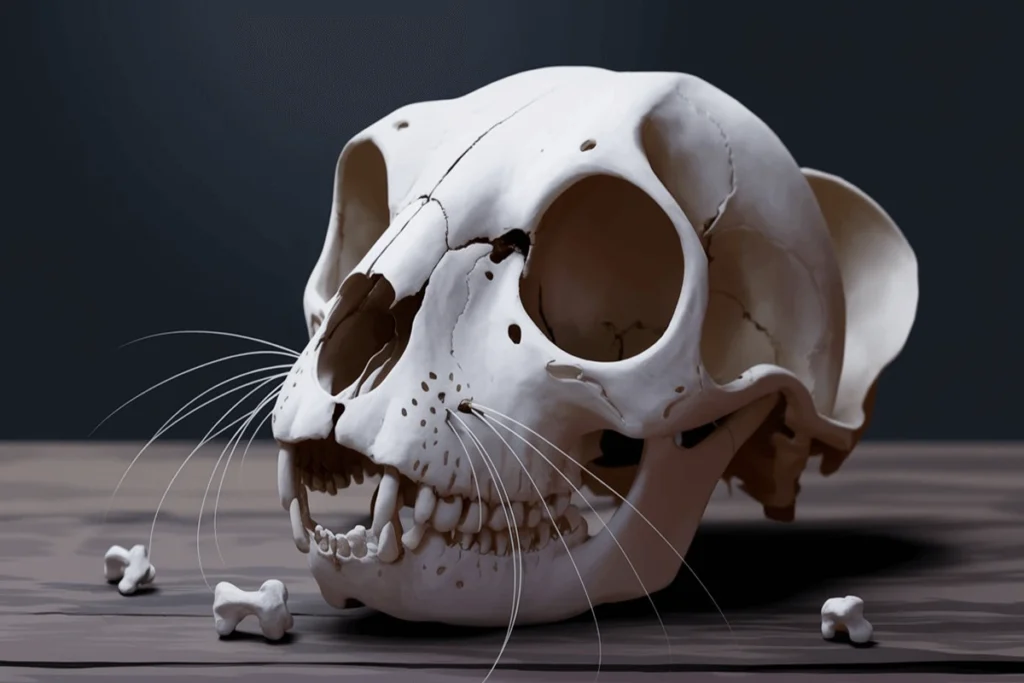
- Streamlined Skull Shape: The smooth, rounded structure of a cat’s skull reduces resistance as they move through dense grass, underbrush, or other obstacles. This streamlined design allows them to approach prey silently, without creating unnecessary noise or disturbance.
- Lightweight Bone Structure: Cat skulls are lightweight yet strong, enabling cats to remain agile and quick on their feet. The reduced weight minimizes the energy needed for movement, allowing cats to conserve energy for hunting and pouncing.
- Large Eye Sockets for Night Vision: A cat’s skull is adapted to enhance their vision, especially in low-light conditions. Their large eye sockets house eyes that can detect the slightest movement, helping them locate and stalk prey without revealing their position.
- Auditory Precision from Skull Design: The placement and shape of the auditory bulla (a bony structure in the skull that houses the middle ear) amplify their sense of hearing. Cats can detect high-frequency sounds, such as the rustling of a mouse in the grass, and pinpoint the direction of the sound. This ability complements their stealthy movements, ensuring they can locate prey before being detected.
- Jaw Mechanics for Silent Kills: A cat’s jaw is designed to deliver a quick and precise bite, allowing them to subdue prey without prolonged struggle. This feature reduces noise during a hunt and helps them remain undetected by other potential predators or prey in the area.
Whether stalking a mouse or playfully chasing a toy, cats rely on the unique design of their skull to remain the stealthy, efficient predators they’ve evolved to be.
Conclusion
The anatomy of a cat skull tells a fascinating story of evolution, adaptation, and survival. Over millions of years, cats have developed features that make them highly efficient predators. Every aspect of their skull design, from its compact size to its sharp teeth and powerful jaw, showcases their predatory nature.
Cats’ skulls are perfectly suited for hunting. Their sharp teeth and strong jaw mechanics allow them to capture and subdue prey efficiently. Large eye sockets enhance their vision, while sensitive auditory structures give them a crucial edge in detecting movement. The skull’s flexibility helps cats squeeze through tight spaces, adding to their reputation for agility and cunning.
Even domestic cats, no longer reliant on hunting for survival, retain the instincts and anatomy of their wild ancestors. Watching a cat pounce on a toy or squeeze into a small nook reveals these inherited traits. Their movements reflect skills honed through generations of evolution, showcasing their natural abilities as predators.
Understanding the design of a cat skull deepens our appreciation for these remarkable animals. Cats are more than just beloved companions—they are masterpieces of nature. Their anatomy perfectly balances function and beauty, reflecting their history as predators and survivors.
The next time your cat leaps with precision or catches a treat mid-air, take a moment to admire their biology. Their skull, like the rest of their body, is a testament to nature’s brilliance and the art of adaptation.
Learn More about Cats From HERE!
Find good stuff for your Pet On Pet MD Official
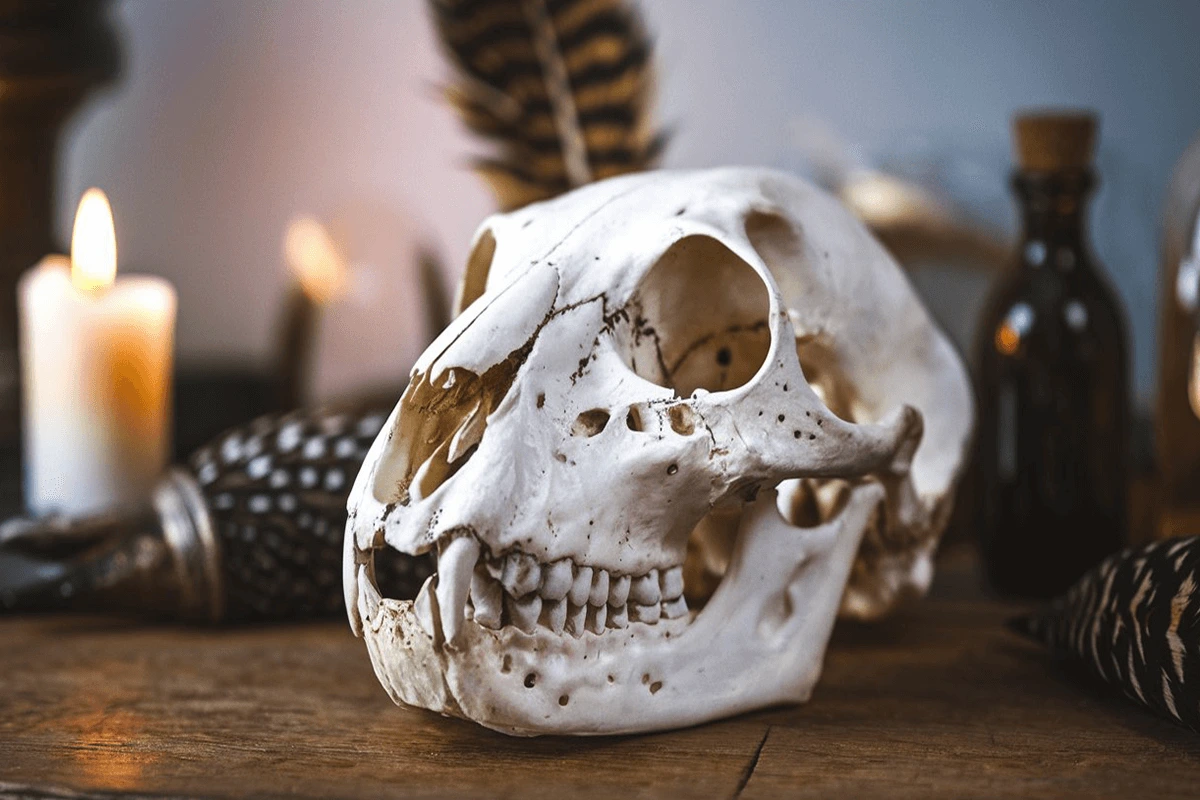
1 thought on “10 Amazing Facts About Cat Skull Anatomy You Need to Know”
Comments are closed.